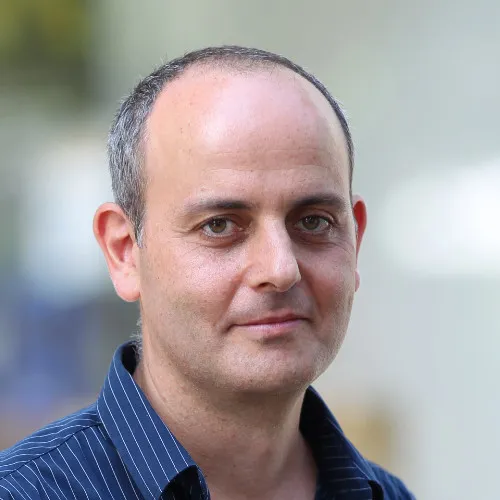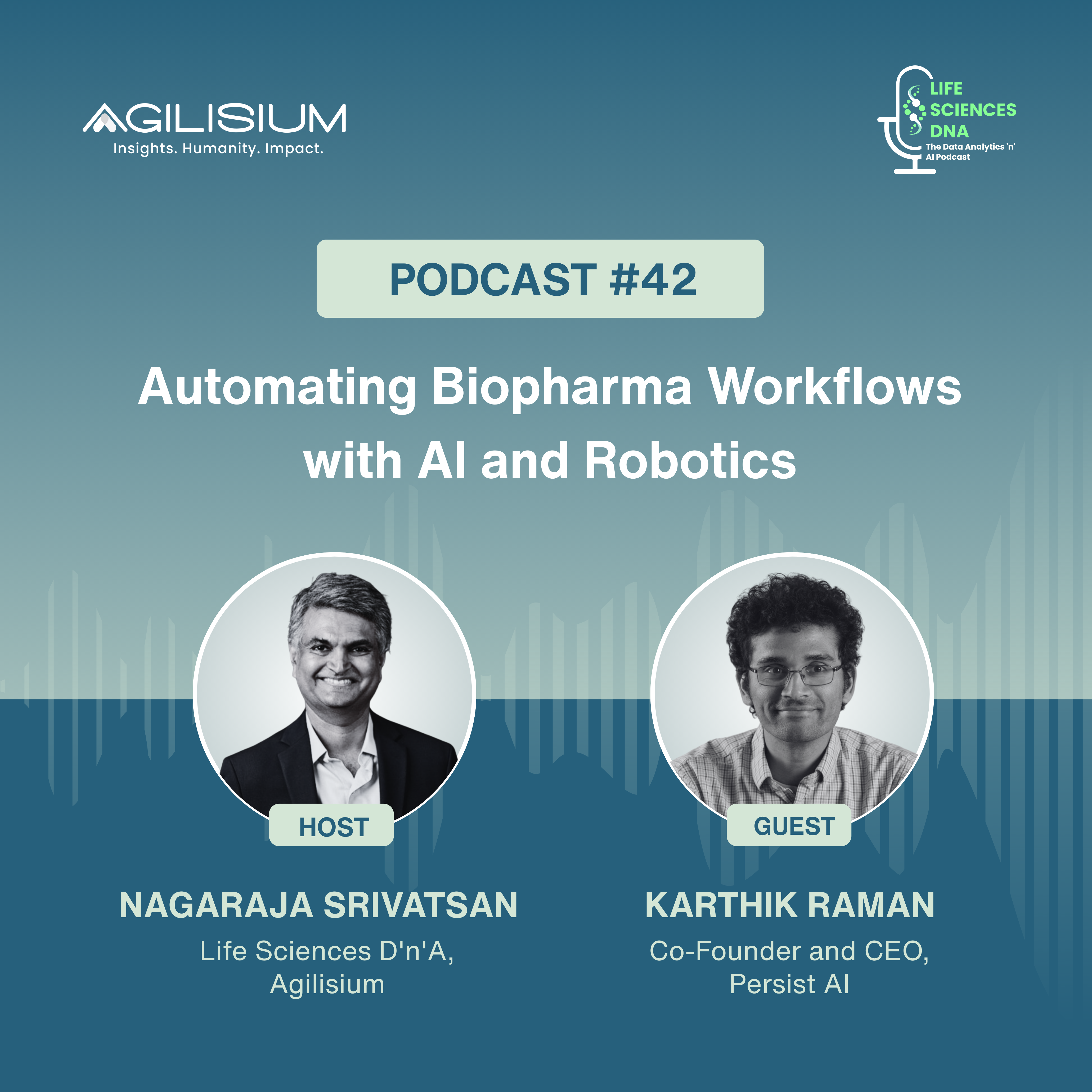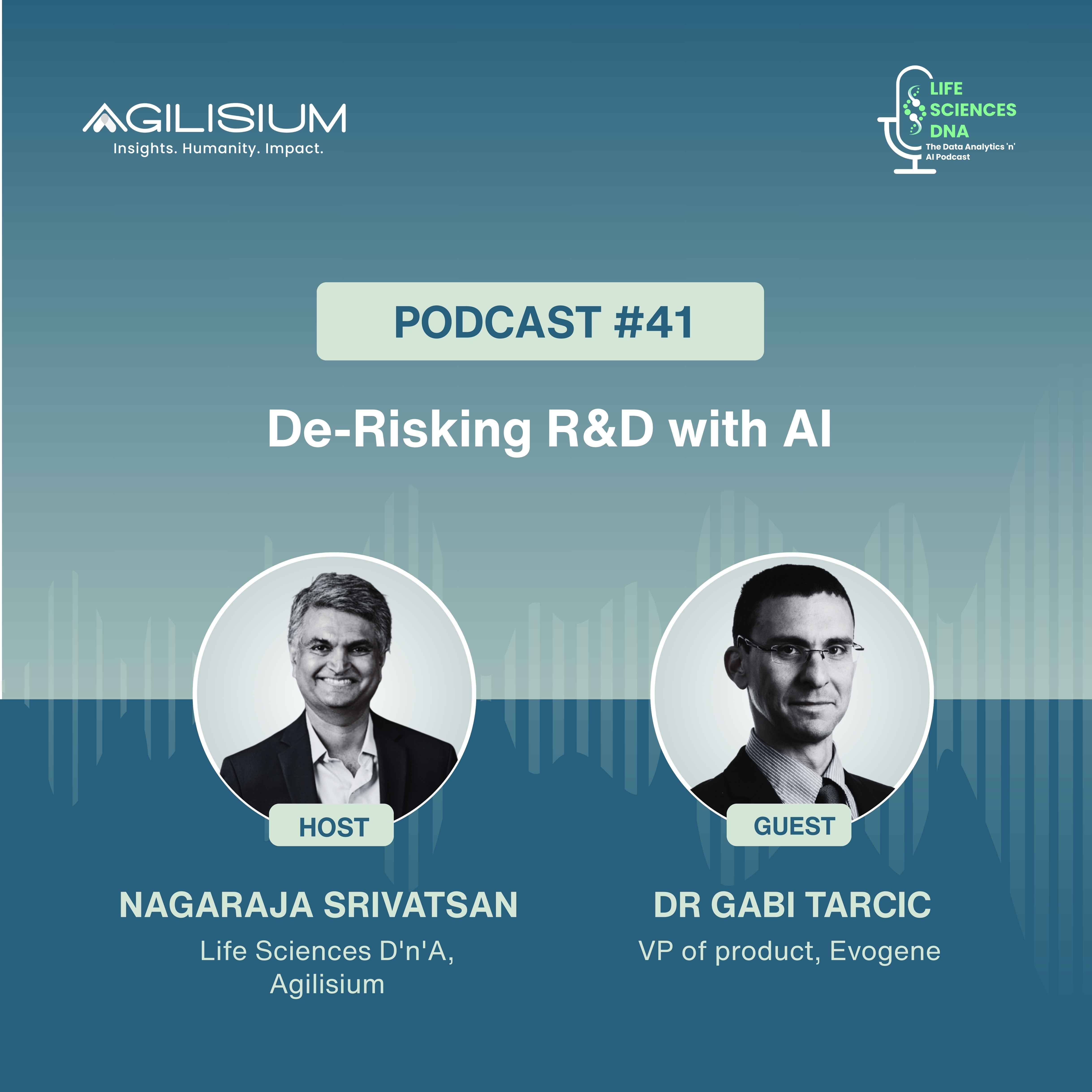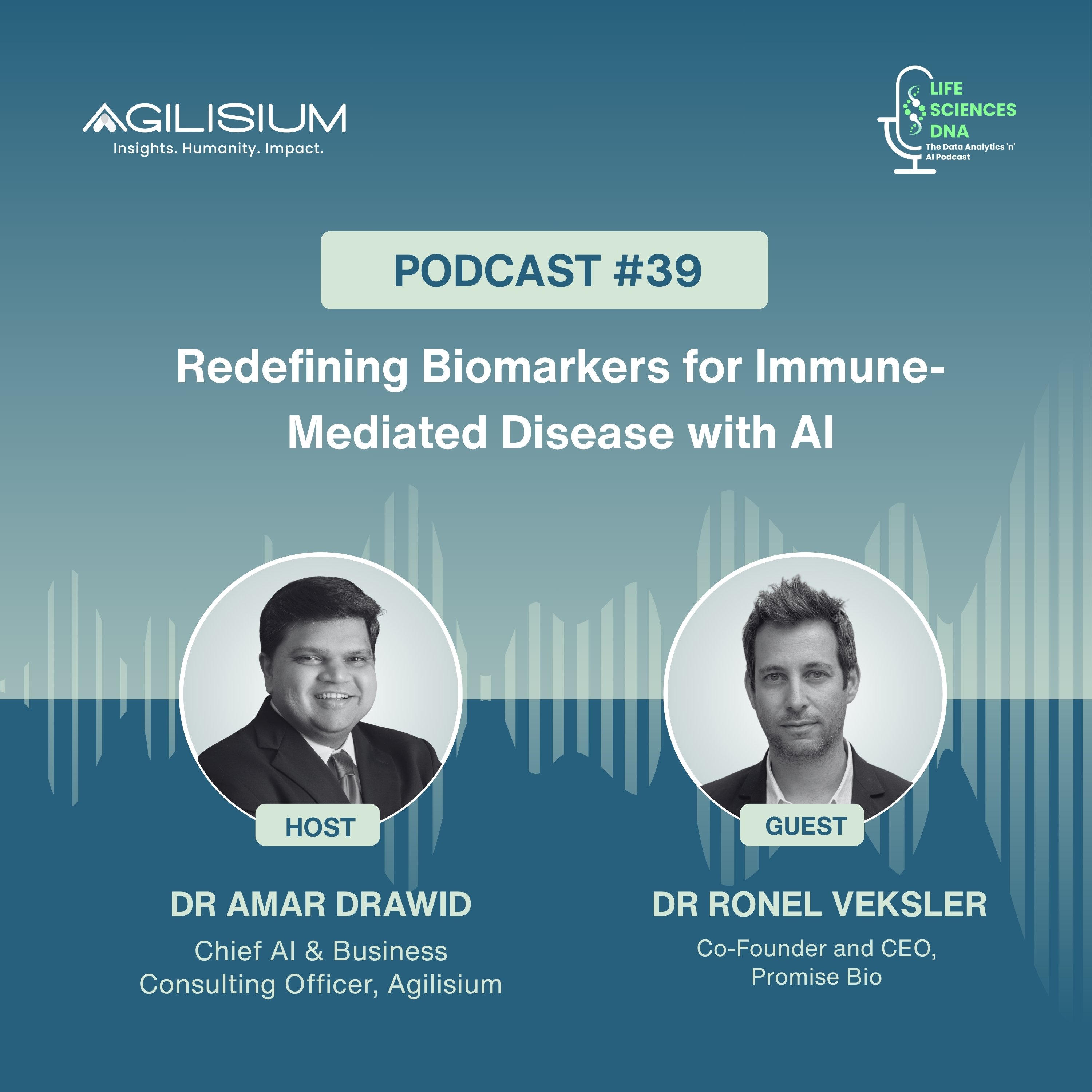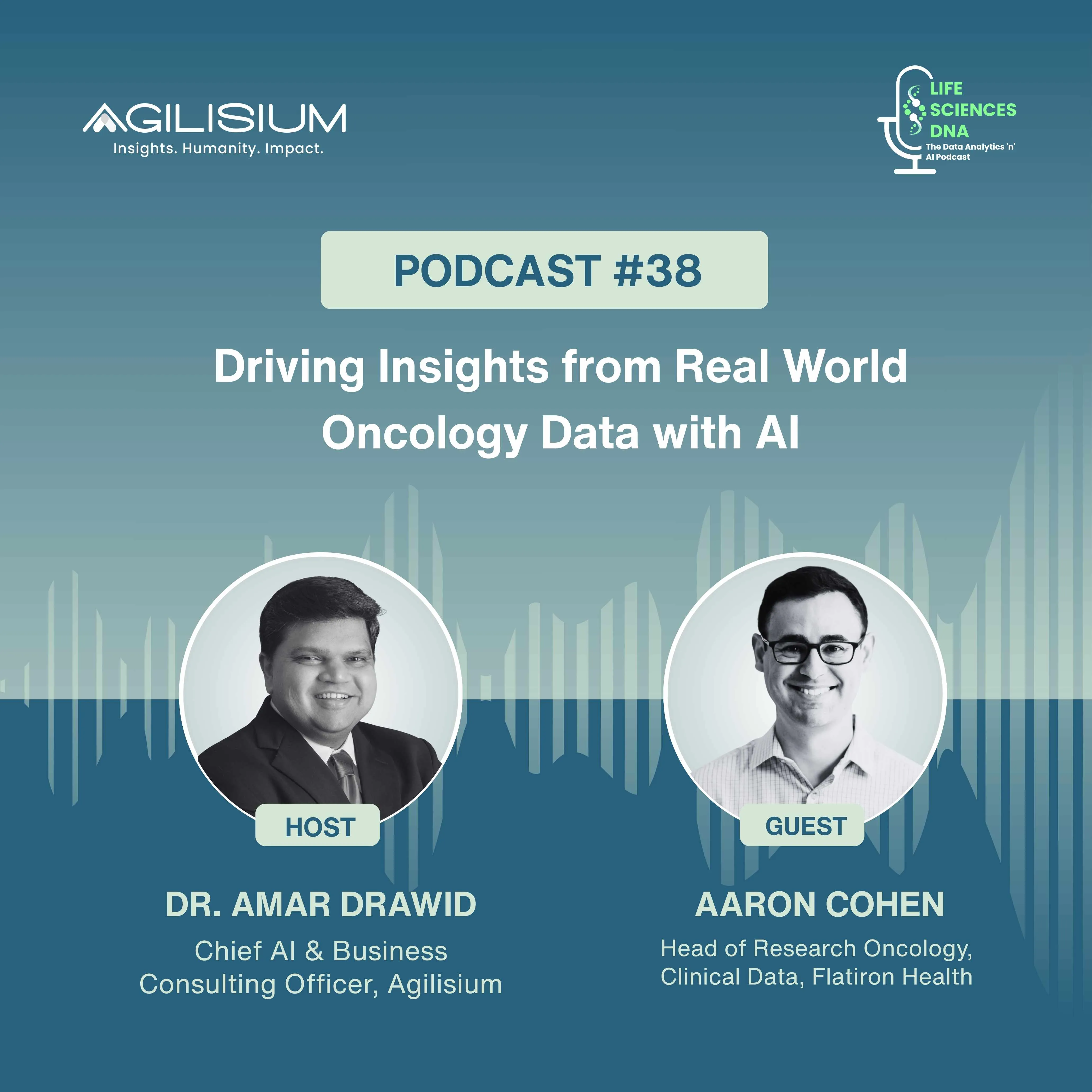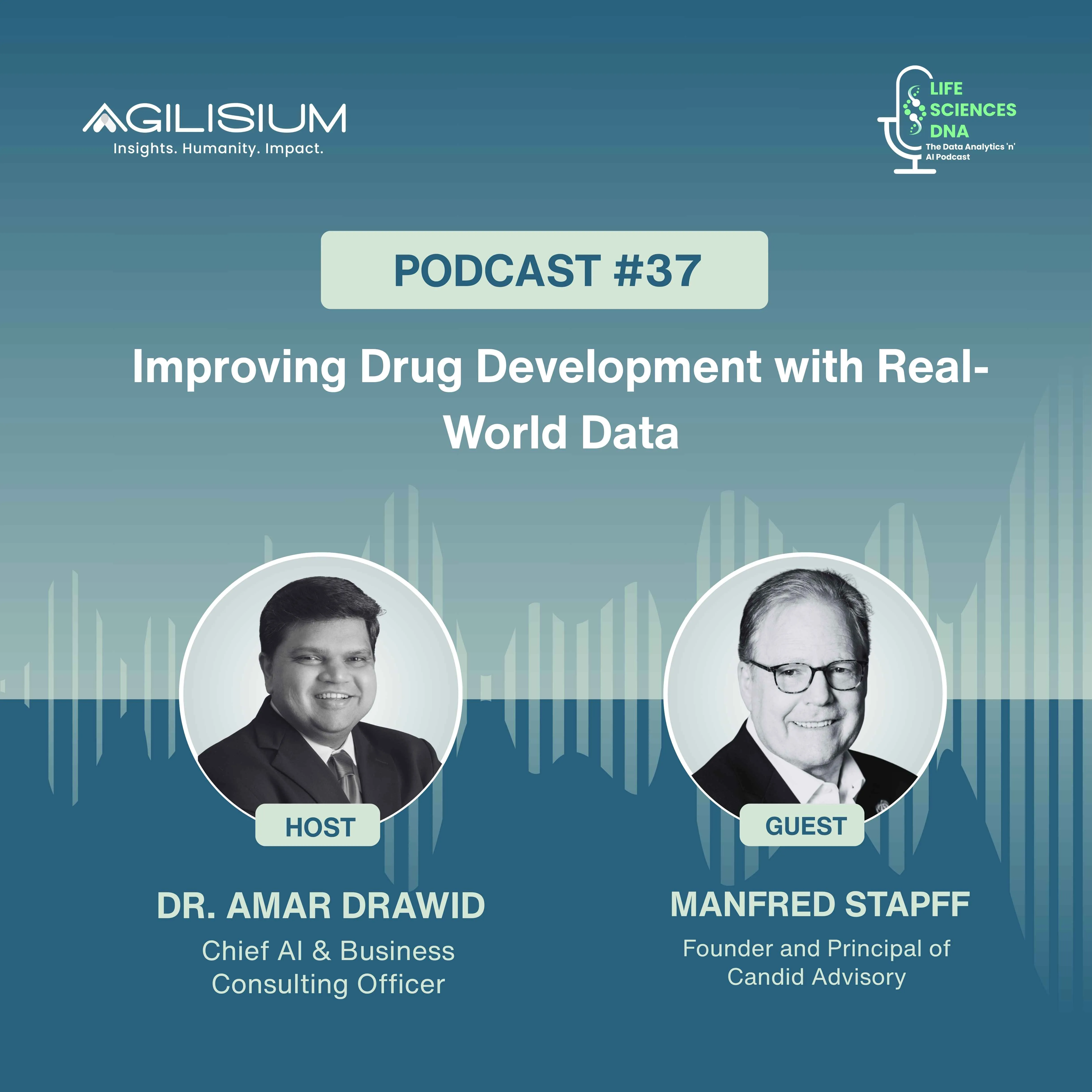Using AI to Revolutionize Precision Oncology
In This Episode
This episode of the Life Sciences DNA Podcast, powered by Agilisium, dives into the fast-evolving world of precision oncology. AI isn’t just playing a supporting role—it’s taking center stage in how cancer treatments are accessed, priced, and made globally viable. The conversation opens up how pharmaceutical companies are using intelligent systems to overcome market access hurdles and bring targeted therapies to the right patients.
- Explains what market access really means for cancer drugs—and why it’s so critical to getting therapies from bench to bedside.
- Explores how clinical benefit, patient experience, and healthcare system impact collectively shape whether a treatment reaches the market.
- Looks at how different countries handle market access—and the unique regulatory challenges in each landscape, especially for oncology.
- Reveals how AI is being used to simulate patient outcomes and strengthen reimbursement submissions with real-world evidence.
- Unpacks how AI helps tailor pricing based on region-specific factors, improving affordability while sustaining business value.
Transcript
LSDNA-Episode 02
Tuvik Beker, CEO of Pangea Biomed
(00:00.398)
The Life Sciences D’n’A podcast is sponsored by Agilisium Labs, a collaborative space where Agilisium works with its clients ranging from early stage biotechs to pharmaceutical giants to co -develop and incubate POCs, products and solutions that improve patient outcomes and accelerate the development of therapies to the market. To learn how Agilisium Labs can use the power of its generative AI for life sciences analytics,
To help you turn your visionary ideas into realities, visit them at labs.agilicium.com.
You're tuned to Life Sciences D’n’A with Dr. Amar Drawid
(01:08.142)
Amar, we've got Tuvik Bekker on the show today. For audience members who may not know Tuvik, who is he? Tuvik Bekker is the CEO of Pangea Biomed. He's a seasoned entrepreneur, executive over the last 20 years and has built companies in healthcare, finance, and aerospace. He's a co -founder of MetaWare. It's an AI -powered safety monitoring platform to check the appropriateness of medications for individual patients. He holds a bachelor's degree in math.
from Tel Aviv University and a PhD in computational neuroscience from the Hebrew University. And what is Pangea Biomed? So Pangea is an interesting company that's seeking to accelerate drug discovery and develop personalized treatment for patients to improve efficacy and outcomes. It has developed a platform technology to enable an understanding of how a tumor would respond to a drug by looking at the molecular environment.
in which a tumor exists. So that's just beyond just the genetic mutations, but also looking at the expression data as well. What are you hoping to hear from Tuvik today? So we're going to dig a little deeper into how Pangea's platform technology works, how they're able to use the data to predict the drugs efficacy and how their interactions with the tumors will be and how Pangea is building a business around this technology.
Well, with that, let's bring Tuvik to the show. Tuvik, thanks for joining us today. We're today going to talk about cancer, Pangea Biomed and precision medicine and how oncology can be. There can be multiple ways to cure oncology using precision medicine and cure our patients. So people have long talked about precision medicine and the emergence of
first therapies have made difference, but still we're not today into the precision medicine as that we were hoping a few years ago. So can you talk a bit more about what is precision medicine or personalized medicine and how it has evolved? Sure. So first of all, thank you, Omar, for hosting me on the show. It's a real pleasure. So we all know that that cancer medicine has undergone
(03:33.262)
a tremendous revolution in the last 20 or 25 years. And it came to be with the better understanding of the molecular basis of cancer. So 40 years ago, let's say cancer was really characterized based on the organ in which the tumor started evolving. So people would try to treat breast cancer versus colon cancer, kidney cancer, et cetera, et cetera. But with the
The advances made in molecular profiling of tumor cells and essentially the understanding the genetic basis that drives cancer. People started understanding that the picture is way more complex. And in fact, kidney cancer is not one type of cancer. You have many, many different types of kidney cancer differing in the molecular drivers.
that determine how this cancer comes to be and how it evolves, how it responds to treatment. And that's the same for any type of cancer. If you want to take it to the extreme, in fact, there are no two cancers that are alike. Every patient has their own very unique cancer characterized by a different set of driving mutations and different sets of abnormalities that...
the cancer exhibits. And these actually also give us the vulnerabilities that we need in order to attack the cancer. So the understanding was that if we find some mutation, which is really the driving force behind a particular cancer, then hitting this particular mutation and disabling this particular mechanism that
lets the cancer grow unchecked or recruit blood vessels or any of the other things that a cancer does in order to proliferate, then we could treat the cancer better. And that was really the beginning of precision oncology and targeted drugs that really try to attack specific molecular mechanisms represented by specific gene abnormalities. Okay, so.
(05:58.03)
A great story, but if we look at the bottom line for patients, 25 years later, we see that there's still a long way to go. Yes, we've got wonderful drugs and sometimes they make wonders. So all in all, it's still a minority of the patients that enjoy remission thanks to modern targeted therapies. And that gap is what we and
many others in the field are really trying to close. Okay. So what you're saying is that instead of, so let's say there's a lung cancer and there is a, let's say a breast cancer. So instead of the traditional medications for lung cancer, so giving whatever the medications have been for that or for breast cancer, instead of specifying those with precision medicine, what we're trying to understand is we understand the mechanism, the molecular mechanism.
of each of these and then maybe there is a drug that is right now specified for breast cancer but that may be actually useful for lung cancer based on the molecular mechanism. Is that what you're trying to do here? That is definitely what we are trying to do. In Pangea, we are really trying to broaden the scope of the application of precision medicine because the way we look at it, the main problem
currently in the field is not that we don't have good enough medicines. We actually have very good medicines and plenty of them. There have been many approvals of novel and effective drugs in the last 20 years. The key problem is that we don't always know which drug is going to be most effective for which patients. So the biomarker question, the predictive biomarkers of
understanding for each particular tumor, which is the most suitable drug, that's still an open question to a large extent. We can answer it sometimes. So there are actionable mutations that when we find them in a particular tumor, say, aha, okay, we know which drug to give that patient. But there are two problems. One, the set of actionable mutations is still limited. We're talking about
(08:24.302)
less than 100 very specific mutations. And most patients just don't harbor any of these mutations in their tumor. So you don't have this vulnerability to act upon. And the second problem is even if you do find such an actionable mutation or fusion or any genomic abnormality, it does not mean that the patient will necessarily respond to the treatment. So the picture is more
complex. You can have two patients harboring an actionable mutation and you give the same treatment to both of them and their medical history is similar. And yet one of them would have a remarkable response and the other would have no response at all. So just the mutations don't tell us the whole story and the question, okay, what would provide the missing information? What will allow us to
be able to predict better which drug should go to which patient. And that's exactly what we are trying to do in Pangea Okay. And we before getting to that, the one thing I wanted to clarify for our audience is the term precision medicine is used a lot. The term personalized medicine is used a lot. And what are your thoughts about those terms? And then to what extent when we say precision medicine is that does every person get
they're a separate new drug or is that we think about specific patients having specific type of molecular mechanisms getting one drug, right? So if you can elaborate that a bit more, that'll be great. Yeah, sure. So these are really broad terms and the definition is open to interpretation. But generally, the holy grail of
precision medicine, precision oncology in particular is that you will really adopt a therapy line for each patient based on more than a broad disease definition. So you'll examine the specifics of the tumor in case of cancer and you'll choose and this choice can still be from a limited number of options. There are
(10:51.63)
a large number of cancer drugs out there to choose from, that two patients with a similar disease in the sense of same organ, same history won't necessarily get the same treatment, which is pretty different from the methodology for choosing treatments right now because the whole regulatory...
apparatus for approving therapies is we take a large group of patients with similar characteristics and we test a drug based on these characteristics. So by definition, we are assigning treatments based on broad characteristics. So this is not exactly precision medicine. We call it precision because
we're still looking for these actual mutations, for example. So it's better than just giving all gastric cancer patients the same drug, but it's not the full scope of what we would like it to be. And as you talked about, right, that there's genetic mutations is one thing, but that's not enough to determine what is the best drug for the patient.
So can you talk a bit more about what you're doing with the ENLIGHT system that you have to really determine what type of drugs should be used for a specific patient? Sure. So with ENLIGHT we are taking a step forward and trying to broaden the aperture through which we examine the tumor molecular composition. And we do it by shifting the focus from the rare
mutations, genetic aberrations to different kind of abnormalities, which is much more common. And these are abnormalities in the expression of genes. So to explain the difference, let's think about the cell as a factory. So the DNA holds the blueprints for the manufacturing. Okay. And it's the plan. A mutation is like
(13:18.19)
a bug in the plan. There's some error in the plan. So obviously everything that you'll do based on this plan would contain some error. But there might be errors further down the road. So you can have a perfect blueprint and you can still manufacture damaged goods because there's a problem with the actual machinery, with the translation or maybe with the copying machine that
copies the blueprint and takes it to the factory floor. So the analogy in biology is a damage not in the genome itself. So coding is intact. And yet in cancer, we see that lots and lots of genes, two orders of magnitude more than genes that are actually mutated, they're not mutated, but they still show expression of normalities. So,
expression of normalities where genes are either expressed significantly more than their normal expression or expressed much less than the normal expression. And these are... And is just like the number of copies, the number of RNA copies that are in the cell, right? Exactly. So, let's say they're supposed to have a thousand copies, but in cancer, maybe instead of a thousand, there might be a million copies.
of a gene and that's a problem, right? So that's the over expression. But yeah, exactly. Exactly. Or on the contrary, they may have no copies at all. And that's an abnormality in the other direction. So looking at this type of abnormality in the number of copies of the gene that are used to actually create proteins gives us a broader
range of vulnerabilities that we can tackle. But it's not that simple because unlike mutations, which are something relatively stable, if a tumor has some mutation, most chances are that this mutation will still be there two weeks or two months or even a year from now if this cancer still exists. But
(15:42.454)
Expression is much more volatile. Expression changes on shorter time spans and the cancer can also modulate the expression of genes in response to external stimuli, for example, in response to treatment. Okay, so it's not a stable phenomenon like the genetic aberrations, but still if we...
can find a way to tackle that it would give us a much broader repertoire of treatments. So what we did with ENLIGHT was really examine the unique fingerprint of expression that we find in tumors. And because of this dynamic nature of the expression, we focused not on single genes with abnormal expression, realizing that this can.
change. Instead, we are looking at large ensembles of genes, which are interconnected. So we're looking for networks of interacting genes that have some functional relationship, and how the abnormal expression fingerprints across such networks of genes can help us understand when a particular treatment would be more or less effective than usual.
interesting. So when you look at these different interaction maps of the genes, how do you connect that with what is the right drug that would be useful for the patient? Okay, so the basic question that we ask ourselves with ENLIGHT is instead of saying, okay, does this tumor have
a driving mutation that we can hit directly. If that's the case, that's great. And we can still tackle it using the same methodology. But the really tough question is, suppose we didn't find a druggable driving mutation, but still we have some drugs and we know a particular drug hits a certain target. Okay, so this target may not be a driver of the tumor. So,
(18:09.966)
might not be enough to just hit it, but if we look at other genes that interact with the target of this drug, maybe we understand the functional relationship between these other genes and the target. What does that mean? Perhaps we can identify certain genes that when we inhibit the target, if they are in an overexpressed state,
that would actually reduce the tumor cell fitness. Okay. Maybe we can identify other genes that act in the opposite way. So if we see them in the severely under expressed state, that would be something that decreases the fitness of the tumor cell. Now decreasing the fitness of the tumor cells means making the therapy more effective. Hey, we're helping the drug to kill.
tumor cells. So essentially, the complex expression based biomarkers that we build with ENLIGHT are based on this premise that we can identify large groups of genes whose abnormal expression state has an effect on the cell fitness. Now, by doing that, essentially, what we're saying is, we have a desired state for these
20 or 50 or 100 genes, some of them we want to see in the overexpressed state and others we want to see in the under expressed or down-regulated state. So that's our desirable state. Now we can go and examine what's actually happening in the tumor. If there's a high degree of overlap between the actual state of this network of genes and our desired state, we would say...
that the tumor has a high ENLIGHT matching score for the drug in question, the drug around which we built this interactions. If the overlap is low, we would say that there's a low ENLIGHT matching score or that this tumor is unmatched for the treatment. OK, so you basically have for all the drugs that are out there, you have like they're the ideal state.
(20:36.43)
for that drug and then you're matching those with how the patient's sample is looking like. Exactly. So we built as the foundational layer of our ENLIGHT technology, we built these genetic interaction maps, which are maps connecting genes across the whole genome. And we have several versions of them. So for common types of cancer, we built
an organ specific network. So for example, for breast, for lung, etc., we have an organ specific network, but we also have a pan cancer network that can help us in cases of more rare tumors. Okay, so we use that in the case of rare tumors. And from these genetic interaction maps, we can then for any drug which has
a clearly defined mechanism of action at the genetic level. So we know which genes it inhibits or which gene products it inhibits. For any such drug, we can build this biomarker, this network surrounding the targets of the drug and derive those predictions based on the overlap between actual state and desired state in our biomarker.
And then for these drugs, the maps that you build for the drugs, are they based off of experiments or are they based off of AI? If you can elaborate that. Both. So they're based off of experiments with lots of AI. So Pangea is really a computational company and we love data. So we try to make use of any data that's available out there.
And that includes very large data sets of both clinical data. So we have tens of thousands of cases of cancer patients with their DNA sequencing, RNA sequencing. Sometimes we have methylation profiles, but these patients sometimes proteomics, lots of omics data for these patients. And we have their.
(23:01.694)
overall survival, the progression free survival, all sorts of metrics of how well did these patients do. So that's one source of data. But we also have genetic experiments that were done on cell lines. So lots and lots of data formed from genetic perturbations of cell lines derived from cancer patients, drug screens where people hit various cell lines with different drugs and
the same for animal models, the same for patient derived xenograph models. So really, ton of data from multiple experiments and real world data, which we interrogate using a wide variety of AI and bioinformatic tools in order to tease out the answer to this basic question that answers us of how are different genes functionally related to each other with respect to their effect in cancer. Okay, okay. Now, when you're using these drugs, are you focused only on the oncology drugs or have there been examples where even a non -oncology drug like, you know, something for immunology or so, you found that that might be actually relevant for a cancer patient? Yeah, so we can actually find repurposing opportunities of non -oncology drugs.
for treating cancer patients. That's definitely the case and it's something that ENLITE can do. It's not our main focus right now for a variety of reasons, but it's definitely doable and something we may be doing more in the future. Okay, great. Now, in terms of, I'm trying to get a sense of for how many patients or what percentage of patients
Are you able to find drugs that are different from what would have been prescribed to them? Can you give us a sense of that? And can you give us a sense of what kind of clinical trials or real world data you have around that? Sure. So, well, there's a wealth of validations that we've already performed in order to prove the merits of this approach.
(25:25.87)
starting from analysis of completed clinical trials. So we analyzed the data from thousands of patients who enrolled in clinical trials and received a wide variety of several dozen different targeted and immune therapy treatments. And we've shown that overall,
ENLIGHT -matched patients had significantly higher chances of response than ENLIGHT unmatched ones. The overall numbers that we reached in one of our publications was 2 .6 times higher odds of response ENLIGHT -matched versus ENLIGHT unmatched patients. But to...
answer your question regarding the coverage, how many patients can we find good matches for? So we actually studied exactly that question in preparation for a clinical trial that's planned to start soon with the National Cancer Institute. And there we had a formulary of 28 different drugs.
from which ENLITE should nominate treatments to patients. And the result that we got was that in almost 90 % of the cases, we can find one of these 28 different drugs that would be ENLITE matched to a patient. Okay, so. And this could be not necessarily for the type of cancer that they were given.
You are correct. You are correct. The 28 drugs are not necessarily on label by current definitions, current marketing authorizations for these drugs for the disease that we'll be trying. But hypothetically, if we were able to choose from a variety of treatments, then we could almost in all cases find some drug which isn't light matched. Of course, a light match does not yet mean
(27:50.83)
It will for sure yield a good response, but we've seen that the chances of that are much higher than the standard of care. And have you like, has there been enough progress in terms of, you let's say you've taken 100 patients, there was you did the matching, maybe there were a certain number of patients.
well, for which, you know, and life predicted that different drugs might be useful. And then they were treated by that and the BCD effects. So do you have like, is there something that you're you've been doing or planning yourself? Yeah. So we don't yet have conclusive prospective data to show that that's one of the purposes of this trial planned together with the National Cancer Institute. That would be.
perspective and interventional trial to test that. However, we do have plenty of evidence that this is indeed the case because for the past few years we have been on occasion approached by oncologists with end of flying cases, patients who have exhausted the clinical guidelines and under such circumstances, physicians are actually allowed and even encouraged to use any kind of research -based information that they can obtain in order to think creatively about how they can treat these patients. So oncologists often call a NOS, and that's a service that we currently provide pro bono. So if a patient has comprehensive molecular analysis from one of several large commercial labs that do these tests, we can reanalyze the data in order to answer these questions by the physicians. And we actually know of several cases where this analysis actually resulted in treatment that went contrary to standard biomarkers and yet resulted in at least three cases.
(30:13.07)
in complete, endurable remission. So patients who were in having very advanced cancer, aggressive disease did not respond to multiple lines of treatment and then responded very well to the ENLIGHT match treatment to the degree of complete disappearance of the tumor, the metastasis, etc. So of course,
Every such case is a celebration. This is the life that you saved, right? I mean, that's exactly. Yeah, that's right. Yeah. And it feels great. I must tell you. Absolutely. Absolutely. So in terms of how you work with the health care system, do you work more with like the oncology centers or you work with the pharma companies? So what is the what is the way that your company works?
So commercially, our activities currently are really focused on helping drug developers bring better drugs to the market more efficiently. That's our only source of income right now. But as I mentioned, we do offer these pro bono service to oncologists. And of course, we are working towards making this available to oncologists and to patients.
as a test, but that would of course require meeting very strict regulatory proofs of the efficacy. So it's something that we're working on, gathering the evidence, running the clinical trials to prove that and we'll do it cautiously over the next couple of years probably. Great. Great.
Yeah. And final question that I have is when you talk to investors about this, right? I this is really a very interesting revolutionary way of curing patients, right? So can you tell us a bit about like how this idea is received and how you know, what is the appetite right now in terms of these type of machine learning supported, you know, repurposing of the drugs?
(32:39.566)
So I think there is wide understanding of the gaps in this field. So people understand the advances made, but also that there is a lot of ways still to go. And I think there's a lot of enthusiasm and especially something we didn't really talk about, but there's a question of
How do you bring it to the point of care? So we have this algorithm, this technology platform that works, but how do you actually test a patient's tumor? So what's the essay? How do you measure the activity? And there, there was recently a very significant and very interesting advance made. So we started that.
with sequencing of messenger RNA. Okay, so by sequencing, not just DNA, but the messenger RNA, we can actually measure the expression of different genes. So, and like was originally developed with messenger RNA sequencing as the technology by which we measure the actual state in the tumor. But what we've shown,
in our latest work is that we can actually perform the same predictive task without requiring sequencing. What we do instead is we trained a machine learning algorithm, a deep learning network to look at pathology slides, the same stained slides that pathologists look at under the microscope in order to diagnose
the type of cancer that a patient has. And we derive directly from the high resolution image of the slide information about the expression levels of the genes that we're interested in now. So it turns out there's a huge amount of information in the images, which is not really exposed to the naked eye. But with AI, you can extract that information.
(35:04.686)
And we've shown using multiple independent clinical trial data sets that we can achieve prediction accuracy, which is on par with what we can do using sequencing machines, but without the several weeks and thousands of dollars that it costs to actually sequence the tumor sample. So I think that's a really big thing for.
the field as a whole and especially for college in developing countries. So I think investors are particularly enthusiastic about this new approach. Great. I mean, I'm just it is fascinating. First of all, the work that you're doing and how the field is changing. And this is just going to make the world much better place with these new, you know,
with the drugs that we already have, but being repurposed for the right patients, right? And bringing the precision medicine for every cancer patient. So thank you very much to Vick Becker, CEO of Panjab Biomed. We really appreciate you being here. Thank you, Ammar. Thanks a lot. It's been a real pleasure. Well, Ammar, what did you think?
It was pretty fascinating how he described about the precision medicine, the state we're in right now, and using the approach of this drug repurposing using AI and using the other drugs that are not really specified or prescribed for the current cancer, but using those to cure patients' lives. And we saw he gave examples of some of the patients.
were cured, you know, they were end of the line, there was no hope, and because of this predictive methodology, the doctors were able to find the right drugs and were able to put these patients in remission. That is amazing in terms of when you look, you know, these were the lives of the patients which were saved because of this technology. Tuvik noted that there is a large arsenal of precision medicines today, but that the challenge is knowing which drug is appropriate for which patient.
(37:28.214)
Accidental mutations are still limited and most patients don't have any of them. Where do you think we are in terms of precision medicine being the standard of care for most patients? I would say personally that we have come a long way, but we still have a long way to go. Right now, when you think about precision medicine and especially from drug development point of view, you have, especially in oncology, you have these,
drugs that are developed against a specific target. So you can look at what the genetic mutation is and develop those. But even when you look at the number of targeted therapies that are out there, I mean it's a sizable number but it's not huge. But then also at this time, when you look at the clinical practice, for the patient's tumor biopsies, we're not going through this kind of a rigorous
a mutational study or the expression study to really figure out what could be the potential of the best drugs. That's still not in practice. We're not doing that right now, right? So I think that needs to happen. Also what needs to happen is we need to have many more drugs so that whatever the mutations that we're seeing among patients, there is a drug available. I don't think we're there right now. I think the drugs are available for a few mutations right now. So...
There is a long way to go in terms of developing the drugs and there's also a long way to go in clinical practice in terms of looking for that. Rather than focusing on single gene mutations, Pangea's looking at large networks of genes and how they interact. What do you think of that approach? I think that's a great idea because see, as Tuvik described, the cell is a factory and you have a gene is a worker. But the sales are evolved so well that a lot of times if one worker is not doing their job, there's another worker who will take over the job. And so the factory will keep working fine. So that's why we really need to look at, okay, well, which worker is not working, but also who are all the connected workers who may take on the job. And so we have to look at this
(39:53.612)
overall network of these workers or the network of these genes and then really figure out what is going to be the effect if you target one gene. So I think that is the right way to do about it. It does seem like this is the type of problem AI is well suited to tackle given the complexity and the large amount of data you need to do this. What do you think the potential for AI is to really bring us to an era of precision medicine and impact?
outcomes for patients in a meaningful way? I mean, to me, you have to use machine learning for something like this, because we're talking about over 20 ,000 genes. We're talking about millions or billions of millions of mutations. You're talking about expression profiles, which are very complex. So just the sheer amount of data that's needed here, it is impossible to do it without machine learning. And also the amount of data that we have. So Tuvik talked about using neural networks and the deep learning for that. Those are the kind of areas where we need to use for this. So I would say AI is essential for something like this to go forward. Well, there's a lot to think about there. I'm looking forward to our next conversation. Amar, thanks for your time today. Thank you, Dan. Thanks again to our sponsor, Agilisium Labs.
Life Sciences D’n’A is a bi -monthly podcast produced by the Levine Media Group with production support from Fullview Media. Be sure to follow us on your preferred podcast platform. Music for this podcast is provided courtesy of the Jonah Levine Collective. We'd love to hear from you. Pop us a note at Danny at levinemediagroup .com. For Life Sciences D’n’A and Dr. Amar Drawid I'm Daniel Levine. Thanks for joining us.



